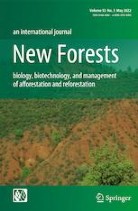Ver ítem
- xmlui.general.dspace_homeCentros Regionales y EEAsCentro Regional Patagonia NorteEEA BarilocheArtículos científicosxmlui.ArtifactBrowser.ItemViewer.trail
- Inicio
- Centros Regionales y EEAs
- Centro Regional Patagonia Norte
- EEA Bariloche
- Artículos científicos
- Ver ítem
Growth response of Pinus contorta to the synergy of stress factors: successive extreme drought events and a population outbreak of Sirex noctilio in NW Patagonia
Resumen
The synergy of biotic and abiotic stress factors influences the response in growth, resistance, recovery and resilience of forest systems. This study used a dendrochronological approach to analyze the annual radial increase and basal area increments (BAI) of Pinus contorta in relation to successive extreme drought events and their influence on tree susceptibility to Sirex noctilio attack. Based on climatic variables (mean temperatures and mean monthly
[ver mas...]
The synergy of biotic and abiotic stress factors influences the response in growth, resistance, recovery and resilience of forest systems. This study used a dendrochronological approach to analyze the annual radial increase and basal area increments (BAI) of Pinus contorta in relation to successive extreme drought events and their influence on tree susceptibility to Sirex noctilio attack. Based on climatic variables (mean temperatures and mean monthly rainfall), the standardized precipitation evapotranspiration index was determined and used to characterize drought events and their succession from 1993 to 2012.
Annual radial increase was measured on cores from healthy trees and trees attacked by S. noctilio. Growth before, during and after each drought event was recorded, and resistance, recovery and resilience indexes were calculated from BAI. The BAI values of healthy and attacked trees differed as from the drought event that occurred in 2002 (Mann Whitney Wilcoxon test, p ≤ 0.05). Healthy and attacked trees had similar resistance to the first characterized drought event of 1998–1999, while attacked trees had lower resistance after the successive drought events analyzed (one-way ANOVA, p ≤ 0.05). Healthy trees had higher recovery and resilience rates in the drought events analyzed. The highest tree mortality due to S. noctilio occurred in 2008, after successive drought events. These results are discussed in relation to silviculture and pest management inplantations
[Cerrar]

Fuente
New Forests (Published: 21 February 2022)
Fecha
2022-02
Editorial
Springer
ISSN
0169-4286
1573-5095
1573-5095
Documentos Relacionados
Formato
pdf
Tipo de documento
artículo
Proyectos
(ver más)
PICT-2012-2892 “Sensibilidad y resiliencia a la sequía de las principales especies forestales implantadas en el noroeste patagónico”
INTA/2019-PE-E4-I074-001/2019-PE-E4-I074-001/AR./Manejo Integrado de Plagas
Palabras Claves
Derechos de acceso
Restringido
 Excepto donde se diga explicitamente, este item se publica bajo la siguiente descripción: Creative Commons Attribution-NonCommercial-ShareAlike 2.5 Unported (CC BY-NC-SA 2.5)
Excepto donde se diga explicitamente, este item se publica bajo la siguiente descripción: Creative Commons Attribution-NonCommercial-ShareAlike 2.5 Unported (CC BY-NC-SA 2.5)

